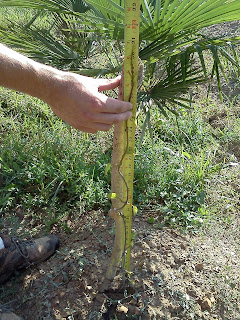Yam Day update!
This week, we get down and dirty to show you how Igbos traditionally farmed yams. Like any farm around the world, Igbos start their work in the off-season. This means they start in the dry season, when farmers clear huge swathes of rainforest to make room for their crops. If you ever visit during this time of year (usually October through March), you may have the chance to see complete pan-optic clouds of smoke rising on the horizon. This is because Igbos today still use the slash-and-burn method to clear land. A good farmer will save as many palm, banana, and plantain trees as possible to use for food, oil (for diet, candles, and personal hygiene), thatch, and palm wine, among many other uses.
After a farmer has cleared his land, he will wait until the transition period into the rainy season, which starts sometime in April. He will then begin making hundreds of large mounds of dirt with his hoe, or ogu in Igbo, leaving small patches untouched where his wives will plants other vegetables. Interestingly, there is no reason of patterning for the organization of the farm. The mounds take shape wherever the man desires, and often he and his wives are the only people who know the outlay of the farm. A smart farmer will wait to plant his yams until he is sure the heavy rains will stay. A farmer often begins planting after the first heavy rains, only to find a period of drought before the real rainy season occurs.
If the farmer plants his yams at the right time of the season, and his yams have begun to sprout like ours have at the museum, he trains his vines to grow around a stick, making sure there are no breaks and that they receive optimum sunlight. If the sun is too hot, he'll use the banana leaves from the trees around his farm to make rings around the yam leaves to avoid scorching and wilting. This continues through the rainy season until it is time to harvest, sometime between August and October. The women weed and maintain the other crops, farming side-by-side with the men.
Below are some of the most important tools for a farmer. The three implements on the left are the hoes, or ogus, used for digging and weeding. If a farmer is too poor to afford an iron plate, he may use the shoulder bone of an animal. On the right, we have an Igbo axe and pick. Notice how short the handles are!
Here I am, picking away loosening up the dirt to make my yam mounds. Yams require large mounds to keep them underground because they grow very, very large. The largest yam I've heard of was 250 lbs!
Now I am using the short-handled ogu to work up my mound. You really have to put your back into it!
The seed yam is planted just like a regular potato.
After the vine is large enough, the farmer carefully trains the vine around a stick or a piece of bamboo. This must be checked fairly often because of the yam's rapid growth.
WEEKLY UPDATE: Back to our yam experiment. Yam 1 grew 8", hitting 21" tall:
Yam 2 grew about 18.5" in the last week, standing around 31" tall:
Yam 3/4, the twins, grew about 11" in the past week, a bit slower than Yam 1 and 2:
Because of its incredible growth, we are adding a new botanical Di Ji, Yam 5, making its debut this week at around 43"!
We have one more new yam to report this week, he is the 7th yam to sprout out of the dozen we planted. Stay tuned, because there are more yams on the way!
Next week, we'll show you some pictures of the yams we bought that were shipped from Ghana, and discuss the biggest holiday of the year for traditional Igbos, the New Yam Festival.











No comments:
Post a Comment